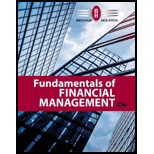
a.
To construct: NPV profile for the given project.
Introduction:
Capital Budgeting:
It refers to the long-term investment decisions that has been taken by the top management of a company and that are irreversible in nature. These decisions require investment of large amount of cash of the company.
It is a method under capital budgeting which includes the computation of the net present value of the project in which company is investing. The calculation is done by calculating the difference between the value of
b.
To explain: Whether the project should be accepted or not at 10% WACC and 20% WACC.
c.
To identify: A situation where the negative cash flows during or at the last of the project’s life might lead to multiple
Introduction:
Internal Rate of Return (IRR):
It refers to the rate of return that is computed by the company to make a decision of selection of a project for investment. This rate provides the basis for selection of projects with a lower cost of capital and rejection of project with a higher cost of capital.
d.
To calculate: MIRR of the project at 10% and 20% WACC.
Introduction:
Modified Internal
It refers to the rate of return that is computed by the company to make a decision of selection and ranking of a project for investment. This is a modified version of IRR with reinvestment of cash flows at the cost of capital.
Trending nowThis is a popular solution!

Chapter 11 Solutions
Fundamentals of Financial Management (MindTap Course List)
- Solve this finance question.arrow_forwardCalculate emi solarrow_forwardAccording to car experts, which of the following ordinarily provides the best value in automobile ownership? Always buying a new car and driving it only a few years. Buying a relatively new used car and driving it for a long time. Buying the cheapest used car available.arrow_forward
- Pat and Chris have identical interest-bearing bank accounts that pay them $15 interest per year. Pat leaves the $15 in the account each year, while Chris takes the $15 home to a jar and never spends any of it. After five years, who has more money? Explarrow_forwardSolve this finance with no aiarrow_forwardExplain about corporate finance? no aiarrow_forward
- Solve it Pat and Chris have identical interest-bearing bank accounts that pay them $15 interest per year. Pat leaves the $15 in the account each year, while Chris takes the $15 home to a jar and never spends any of it. After five years, who has more money?arrow_forwardFinance question subject. solvearrow_forwardNo ai answerarrow_forward
- Dont use ai solvearrow_forwardThe Short-Line Railroad is considering a $140,000 investment in either of two companies. The cash flows are as follows: Year Electric Co. Water Works 1.................. $85,000 $30,0002.................. 25,000 25,0003.................. 30,000 85,0004–10 ............ 10,000 10,000a. Using the payback method, what will the decision be? b. Using the Net Present Value method, which is the better project? The discount rate is 10%.arrow_forwardSkyline Corp. will invest $130,000 in a project that will not begin to produce returns until after the 3rd year. From the end of the 3rd year until the end of the 12th year (10 periods), the annual cash flow will be $34,000. If the cost of capital is 12 percent, should this project be undertaken?arrow_forward
 Intermediate Financial Management (MindTap Course...FinanceISBN:9781337395083Author:Eugene F. Brigham, Phillip R. DavesPublisher:Cengage Learning
Intermediate Financial Management (MindTap Course...FinanceISBN:9781337395083Author:Eugene F. Brigham, Phillip R. DavesPublisher:Cengage Learning
 EBK CONTEMPORARY FINANCIAL MANAGEMENTFinanceISBN:9781337514835Author:MOYERPublisher:CENGAGE LEARNING - CONSIGNMENT
EBK CONTEMPORARY FINANCIAL MANAGEMENTFinanceISBN:9781337514835Author:MOYERPublisher:CENGAGE LEARNING - CONSIGNMENT Managerial AccountingAccountingISBN:9781337912020Author:Carl Warren, Ph.d. Cma William B. TaylerPublisher:South-Western College Pub
Managerial AccountingAccountingISBN:9781337912020Author:Carl Warren, Ph.d. Cma William B. TaylerPublisher:South-Western College Pub Financial And Managerial AccountingAccountingISBN:9781337902663Author:WARREN, Carl S.Publisher:Cengage Learning,
Financial And Managerial AccountingAccountingISBN:9781337902663Author:WARREN, Carl S.Publisher:Cengage Learning,





